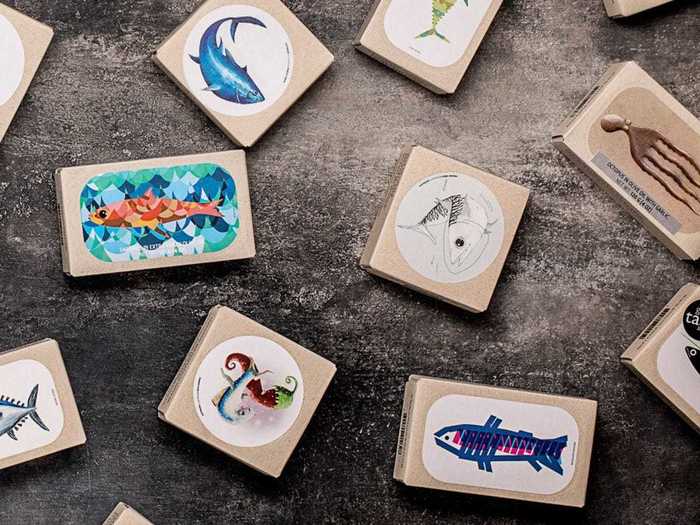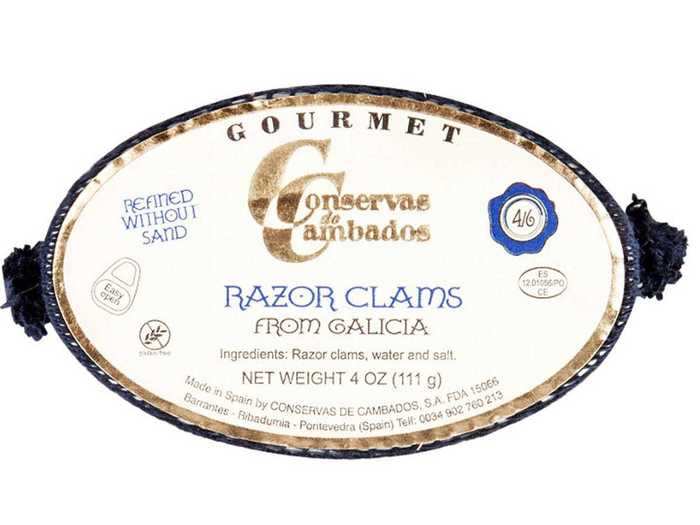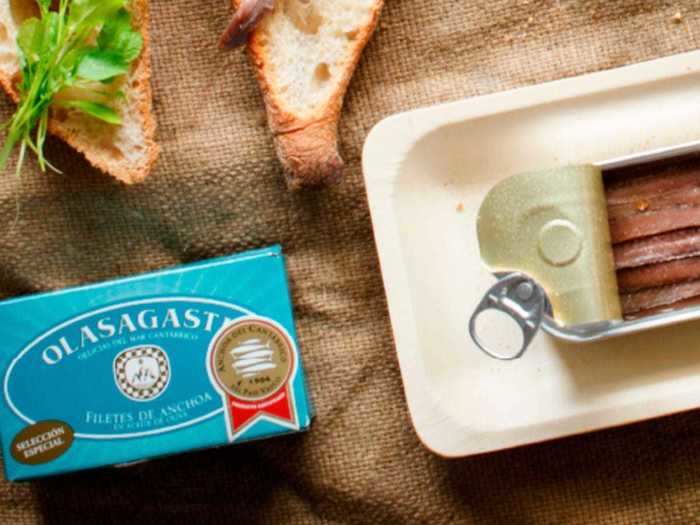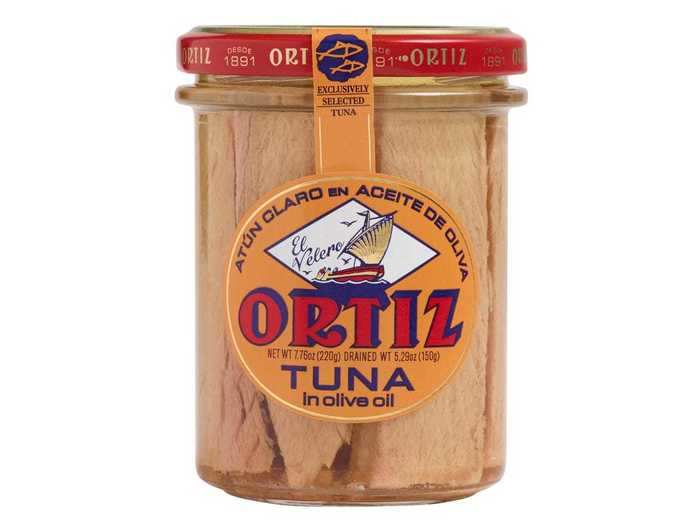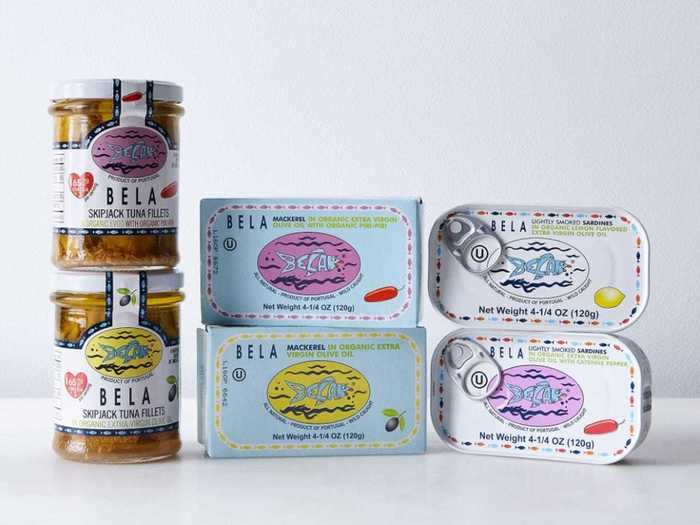The best canned, jarred, and preserved seafood to eat and cook beyond just tuna
Owen Burke
When you buy through our links, we may earn money from our affiliate partners. Learn more.
- The phrase canned seafood might conjure up images of soggy tuna sandwiches, but conservas, as preserved fish and shellfish are reverentially known on the Iberian peninsula, are nothing if not versatile and healthy.
- We spoke with the Monterey Bay Aquarium Seafood Watch program and consulted the Environmental Working Group (EWG) on which canned fish and shellfish are best for us to eat, and which are best left to the sea.
- What did we learn? A can or jar that claims sustainability is not necessarily sustainable, but wild salmon, herring, sardines, and even some varieties of tuna are all good choices (with a few stipulations), as are most shellfish including oysters, clams, and mussels.
While fresh and frozen meat and seafood suppliers experience shortages and other complications, it's high time we get creative with our diets and learn to love and appreciate the centuries-old art form of preserving fish and shellfish. And we're not talking about your typical utilitarian tuna sandwich here; canned, tinned, and jarred seafood — or conservas as it's more affectionately known on the Iberian peninsula — can be a bonafide delicacy, if you know where to shop.
Plus, if you're anything like us at this stage of quarantine — scouring the internet for recipes, tips, and tricks on what to do with sundry dry goods and nonperishables in your pantry — you know there's no better time than the present to get familiar with les fruits de mer. After all, canned and jarred fish may well be the superlative survival food. Packed with protein and uniformly compact, there's no telling how many cans of sardines, oysters, herring, and, yes, tuna, you can reasonably stack in your cabinets or in the trunk of your car.
To get an idea of what to look for, we rang up the Monterey Bay Aquarium Seafood Watch program. "The best product is the product that you have some information about," says Senior Program Manager, Ryan Bigelow. "There are sustainable items, or responsible items if you're more comfortable with that term, across the gamut…there are companies that are trying to do it better, and you can certainly see that in the canned space as well."
The best way to find out whether or not a can of preserved seafood is sustainable isn't to take its label for gospel, but to figure out the place of origin (or landing) of the fish and the method by which it was caught. This will help you steer clear of foods produced using questionable practices, which can involve anything from indentured servitude to ruthless environmental degradation.
Sustainability vs. nutritionBut how do we navigate the murky waters where sustainability and nutrition intersect? Groups like the Monterey Bay Aquarium Seafood Watch program and the Marine Stewardship Council (MSC) highlight sustainable choices and set environmental standards, while the Environmental Working Group (EWG) offers nutritional ratings and guidelines, but these recommendations are often at odds when your health and the oceans' health come into play.
Your best bet is to compare and contrast the Monterey Bay Aquarium Seafood Watch's full list of recommended species (the MSC can be helpful, too, but maintains slightly looser regulations around fishing methods) and the EWG's database of scores for canned fish.
By and large, the overarching message from Seafood Watch, the MSC, and the EWG, is that the best thing we can do when shopping for fish is to limit our consumption of bigger, more popular species such as tuna (pole-and-line-caught skipjack and albacore are exceptions) and salmon (apart from pink and sockeye, many salmon species are woefully overfished in the wild, and farming brings its own complications). Smaller species like herring, sardines (though only from the North Pacific) and shellfish (farmed or wild) tend to be both more nutritious and environmentally friendly.
We found the best options where Seafood Watch and EWG's ratings (based on a 1-10 scale, 1 being healthiest) intersect and indicated those ratings (when they were available) in our canned seafood roundup, below. We also looked at prices and ultimately (though highly subjectively) tastiness based on experience. In the case of tuna, however, we disregarded the EWG's ratings because, inherently, when you're eating tuna, you're consuming some level of mercury.
Wild Planet offers some of the healthiest (no salt added) and most sustainable canned seafood out there. Its products are also some of the tastiest we've tried; sardines in extra virgin olive oil with lemon are a standout. Wild Planet Wild Sardines In Extra Virgin Oil with LemonEWG rating: 1.6-10 (see unchecked mercury in albacore)
Wild Planet may not offer the same variety as other brands, but chalk that up to attention to detail. The company produces only what it comfortably can, and as the name suggests, everything is wild-caught, and done so in relatively sustainable ways.
In general, the brand doesn't toss in as much salt as others do, but that ratio can vary from product to product. All in all, though, you can feel pretty good about eating sardines from Wild Planet.
As for larger species, it sources "pole and line-caught" albacore tuna from the Pacific Northwest (though their wild sockeye appears to be netted, which is common and considered sustainable), and Seafood Watch green-lights the brand's skipjack tuna.
Wild Planet also sells some of the most responsibly-caught yellowtail amberjack (a prized sushi fish) in a can. They may not be the only brand to include yellowtail in their preserved fish roster, but they do a pretty commendable job of tracking how it's farmed. Seafood Watch says indoor-raised yellowtail (with wastewater management) is best, but you don't really find that in cans (probably because it ends up at sushi restaurants instead). Wild Planet's yellowtail is at least rod and reel-caught, rather than gill-netted or raised in open pens (a method that often causes intermingling with wild fish, which can be a dangerous game).
The bottom line with Wild Planet, though, is that if you're set on eating only wild-caught seafood, it's an easy, all-around good choice. While the prices may not be the cheapest, they're far from the most expensive.
Shop Wild Planet canned seafood at iHerbShop Wild Planet canned seafood in bulk at AmazonSafe Catch's testing standards are the most rigorous in the game, which is why they're our top recommended brand for canned tuna.Safe Catch Canned Wild Ahi TunaEWG rating: 1.5-10 (even though every fish is tested, there's still mercury in albacore)
While tuna salad sandwiches may not be as ubiquitous as they once were, tuna is the canned fish Americans are most familiar with. What you might not realize is that there are 15 species of tuna in the world, and while you'll only see a fraction of them on offer in your local grocery store, it's important to know which varieties are the healthiest and most responsibly caught.
Safe Catch tests every single fish they process for mercury, making their tuna exceptionally low-risk. Mercury, a heavy-metal toxin, is one that bioaccumulates, or piles up from species to species. So while you don't really have to worry about mercury levels in sardines or anchovies, it's something you may want to consider when consuming larger fish —especially pelagic species, or fish that live neither close to the bottom of a body of water nor near the shore — like tuna, swordfish, shark, marlin, and king mackerel.
According to Safe Catch, one out of every three fish it reels in has mercury levels higher than what the FDA recommends, and therefore doesn't make the cut. In effect, it's the safest canned tuna we know of, particularly for pregnant and breastfeeding women, and children. The brand promises that its tuna contain no more than .1 parts per million.
It's worth repeating that most canned seafood brands place their focus on either the health of the oceans or the health of the consumer and rarely, if ever, both. Safe Catch doesn't always follow the best fishing practices ("dolphin-safe" doesn't really mean anything), but the brand's albacore is from the Pacific Northwest of the United States and is pole and line-caught, which is the most sustainable way to harvest tuna. And while Safe Catch gets a pretty bad score for its tuna — 5-7 with the Environmental Working Group (EWG) — we disagree with the organization's ratings, which do not acknowledge the brand's mercury-testing process.
Safe Catch also offers excellent sockeye and pink salmon (an easy replacement for chunk-light albacore tuna meat), as well as sardines — all of which happen to have some of the EWG's best ratings (1.5-2.4). Salmon is the most responsible of the larger ocean-dwelling species available in a can, and there are a few reasons for this, according to seafood guru Paul Greenberg, author of Four Fish, American Catch, and The Omega Principle: First, we know (roughly) how many salmon there are in the wild, while we'll probably never be able to get an accurate count on tuna. Second, salmon eat smaller fish, and therefore accumulate fewer toxins than tuna (specifically mercury). And third, salmon fishing isn't nearly as damaging to the marine environment as tuna fishing.
Shop Safe Catch at Thrive MarketShop Safe Catch in bulk at AmazonHerring and sardines from Crown Prince aren't just some of the best-tasting preserved finfish you can eat — they're among the cheapest, too.Crown Prince Smoked OystersEWG rating: 2-9
Yes, canned (and jarred) seafood can get very, very expensive (ever heard of caviar?). While tuna and salmon shouldn't be skimped on — unless you want to risk consuming fish with high (or at least unchecked) mercury levels or purchasing something questionably processed — you can often find quality sardines and herring at affordable prices. Since the bycatch and environmental costs of harvesting these smaller species are relatively low, stricter standards and more expensive catch methods don't have to be employed.
Crown Prince is best known for its sardines and kippers, or herring. The brand offers other species, but while Crown Prince does report working within the sustainability parameters set by the Marine Stewardship Council (MSC), as well as Friend of the Sea, we find their catch methods surrounding larger fish to be questionable. For example, if you have a modicum of concern for the oceans' preservation or workers' rights, you may want to consider avoiding pelagic fish, such as tuna, from anywhere but the United States, according to Monterey Bay Aquarium's Seafood Watch organization. (Crown Prince's yellowfin and skipjack tuna come from the Maldives, and its albacore is caught in Thailand, where human rights violations in fisheries continue to abound despite relatively harsh sanctions from the US).
We should note that while you can easily spend upwards of 10 bucks on a can of luxury-brand sardines, higher prices don't necessarily ensure better quality or stricter environmental safety standards. You should, however, be on the lookout for high sodium levels, particularly in anchovies, which are drenched in salt (white anchovies are the exception, but they're often pricier).
If you're trying to cut back on sodium, go for the stuff packed in water rather than oil and avoid salt-rich seasonings (dressing canned fish yourself is almost always healthier). Crown Prince's EWG ratings range from 2.0 to 2.6, which is on the higher end in regards to your health, but, again, we think they fall short when it comes to fair practices and environmental impact.
Another good affordable option across the board is King Oscar. The brand's preserved fish tends to have higher sodium levels (17% of the recommended daily value versus Crown Prince's 10%), but that's about the only difference we can discern, apart from specific products that are labeled "organic" and "non-GMO project verified."
There also might be BPA finish on King Oscar's cans (to help prevent botulism), but, as the FDA explains, Bisphenol A doesn't pose the same risk here as it does when it's coating your water bottle.
Shop Crown Prince at Thrive MarketShop Crown Prince in bulk at AmazonThere's no shortage of good, responsible purveyors of high-quality, ethically sourced canned seafood. Look to your local markets first — they need your help now more than ever — but if you can't manage to find what you want, Patagonia Provisions is widely available online and offers plenty of variety.Patagonia Provisions Savory Sofrito MusselsEWG rating: 2.8-5
Who makes the best gourmet canned seafood? It's a tossup, and highly subjective, but if you don't have a local shop that specializes in conservas we recommend looking to Patagonia Provisions (definitely try their mussels, a species that is sustainably farmed off Galicia, Spain).
In New York City, we're lucky enough to have establishments like Maiden Lane (their online store also has an extensive selection), which stocks some of our other favorites: Jose Gourmet, Conservas Cambados (shellfish), Olasagasti (tuna), and Ekone (Washington State smoked oysters).
When it comes to smaller, more artisanal brands, you'll want to check their practices against the Monterey Bay Aquarium's Seafood Watch "Seafood A-Z" guide. No matter what species of fish or shellfish you're after, it's probably in there, and under the listing you'll find the best fishing methods to seek out and support (e.g. pole and line-caught, troll-caught, purse seine-caught, etc.).
Patagonia Provisions is notable for its carefully-handled fish and fillets. When you get into these higher-end brands, you'll often find that the fish is less fishy (because it was cleaned and processed with better attention). In many cases, you'll also find top-notch herbs and garnishes, like lemon slices and bay leaves.
Frankly, some of us would be all too happy living off of the array of gourmet bounties from the brands listed below. But keep in mind that they are the pricey products of superlatively deft artisans, a fact that becomes obvious when you crack open a tin and peer inside to find an impressive display of meticulously dressed and arranged treats.
Read the original article on Business InsiderREAD MORE ARTICLES ON
Popular Right Now
Popular Keywords
Advertisement

